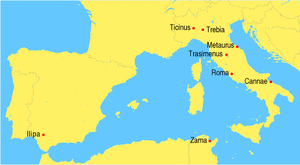Battle of Herdonia (212 BC)
| Battle of Herdonia | |||||||
|---|---|---|---|---|---|---|---|
| Part of the Second Punic War | |||||||
 | |||||||
| |||||||
| Belligerents | |||||||
| Carthage | Roman Republic | ||||||
| Commanders and leaders | |||||||
| Hannibal | Gnaeus Fulvius Flaccus | ||||||
| Strength | |||||||
| 20,000-30,000 | 18,000 | ||||||
| Casualties and losses | |||||||
| Minimal | 16,000 | ||||||
The first Battle of Herdonia was fought in 212 BC during the Second Punic War between Hannibal's Carthaginian army and Roman forces led by Praetor Gnaeus Fulvius Flaccus, brother of the consul. The Roman army was destroyed, leaving Apulia free of Romans for the year.
Strategic situation
Hannibal had destroyed the Roman army in Campania under the command of Marcus Centenius in Battle of the Silarus. After completely wiping out this army in his greatest victory after Cannae, Hannibal chose not to remain in Campania to safeguard Capua. Nor did he march west towards Cumae to confront the consular armies of Flavius Flaccus and Appius Claudius. Instead Hannibal marched east into Apulia.
The Roman consuls decided to march towards Capua. The Romans started to make deliberate preparations to secure their supply lines. They fortified Casilinum, and built forts on the Volturnes River to guard their supply lines. Praetor Claudius Nero's army moved from Lucania to Suessula; in total 6 Roman and 6 allied legions were prepared to move against Capua.
In Iberia, Hasdrubal Barca had moved to Africa to subdue Syphax, and in his efforts was being aided by a Numidian prince called Masinissa. The Scipio brothers had started to recruit and train Celtiberian mercenaries to build up their forces for a major campaign against the Carthaginians.
The battle
Fulvius and his army had had a rather easy time in Apulia, and the Romans were unaware of Hannibal's presence until he was within the immediate area of Herdonia. Fulvius is said to have become careless from his easy successes and his army was also weighted down with loot. Fulvius accepted battle on Hannibal's offer at the behest of his extremely eager soldiers. Hannibal's army probably outnumbered the Romans, who had about 18,000 men available.
Hannibal deployed his forces on the plain outside his camp, while sending about 3,000 light infantry to his extreme left flank to effect a surprise attack from the woodlands and farms located in that direction. Hannibal also sent out 2,000 Numidians to take control of the roads in the rear of Fulvius' army, thus cutting off all escape routes. It is surprising that Flaccus did not detect the deployments of the Carthaginians, which is either a tribute to the skill of Hannibal's commanders or a glaring example of Roman negligence. Hannibal's army, which still outnumbered the Romans after 5,000 soldiers had been detached from it, overwhelmed the Roman legions almost at once. Fulvius fled the field almost immediately with 200 troops as Hannibal's attacks came from the front, behind and to both sides. Roughly 2,000 Romans are said to have survived the battle. This battle resembles the trap Hannibal had set for the army of Minucius at the Battle of Geronium in 217 BC.
Aftermath
In the span of a few weeks, Hannibal had wiped out 6 Roman legions in Campania and Apulia. After this battle, Hannibal marched south towards Tarentum, where the Romans were besieged in the citadel while the town had fallen to Carthaginian allies in 213 BC. The Roman senate decided to raise four new legions to send to Apulia. The Roman consuls then marched nearer to Capua, intent on blockading the city totally.
The reason for Hannibal's retreat south has been a source of puzzlement for some authors. They have speculated that Hannibal had retired to rest his army and give the wounded a chance to recover after three hard fought battles and rapid marches.[1]
References
See also
- Second Battle of Herdonia (210 BC)
Coordinates: 41°19′00″N 15°38′00″E / 41.3167°N 15.6333°E
